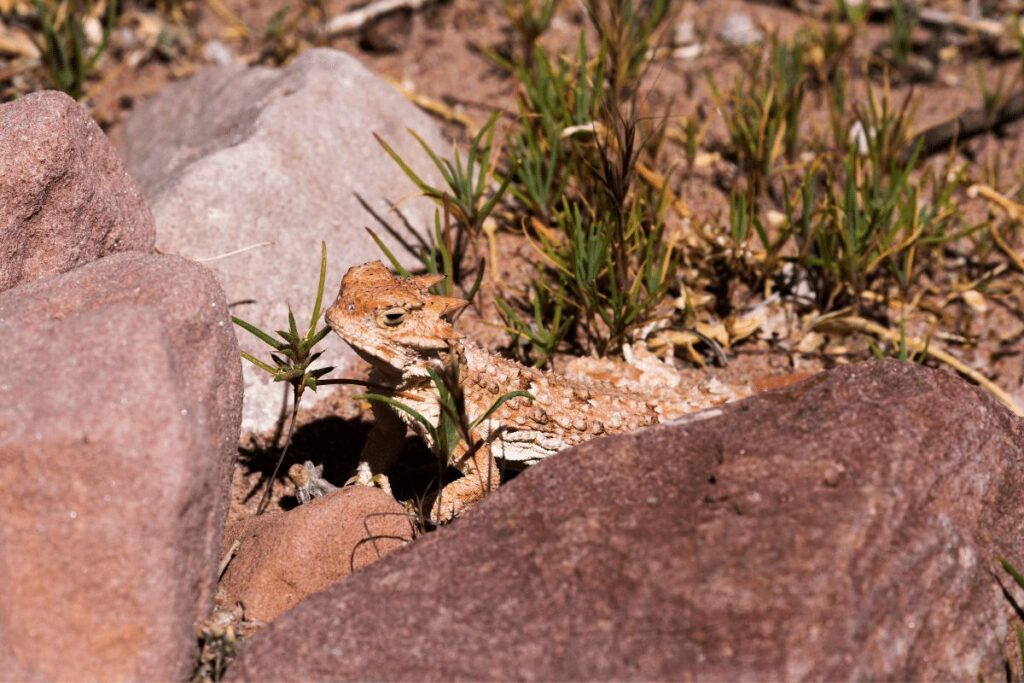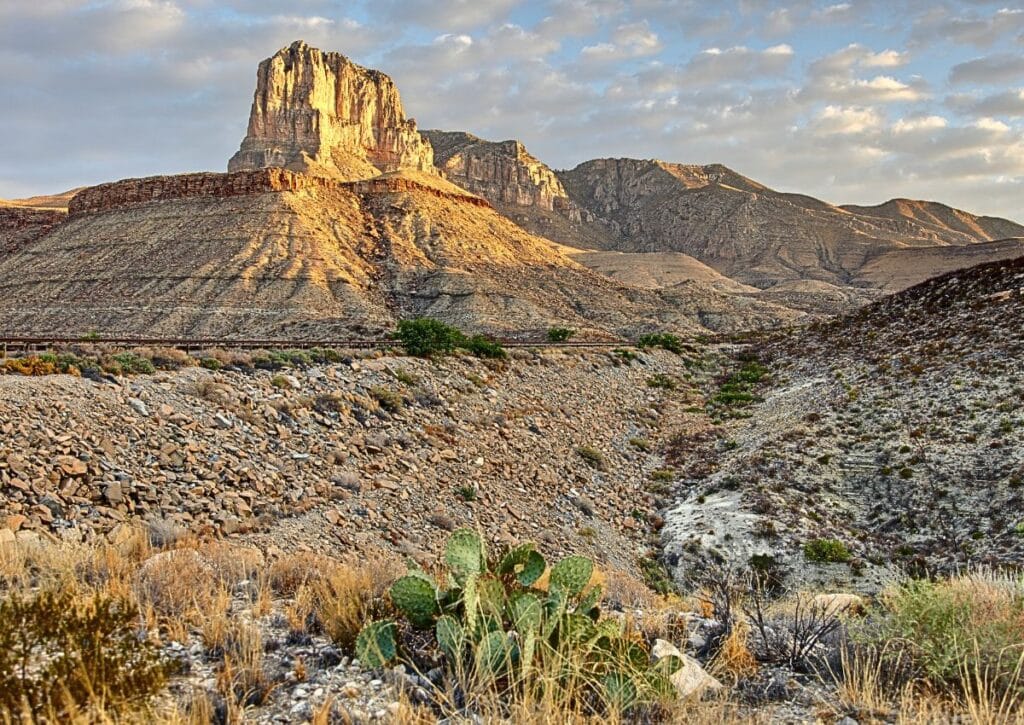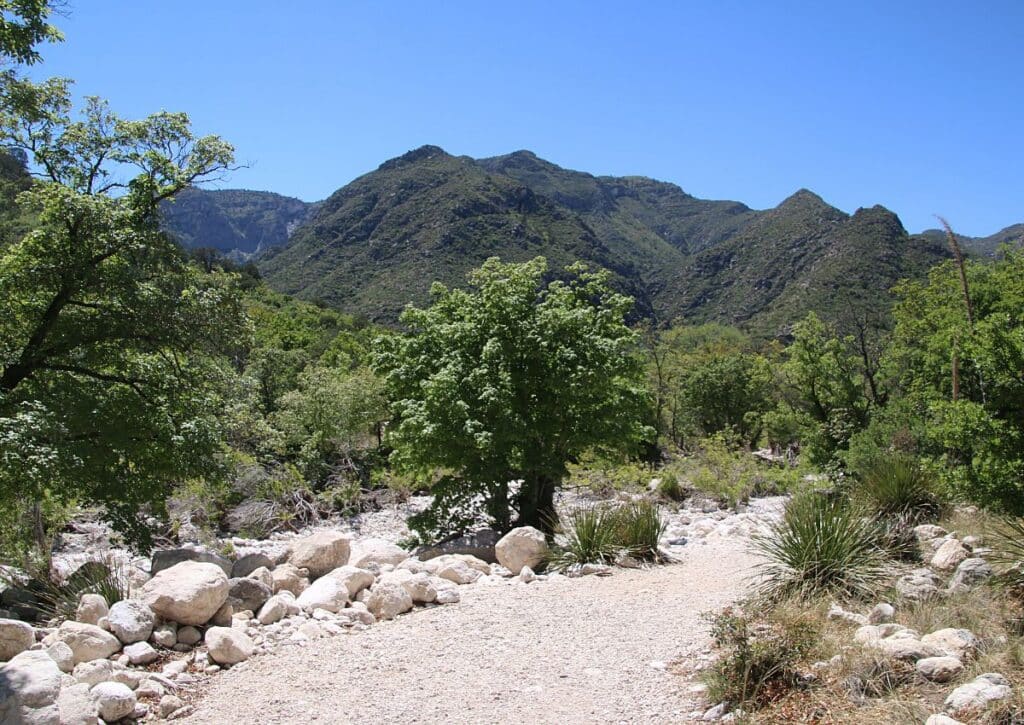Explore the best of Guadalupe Mountains National Park, TX: top trails, history, wildlife & camping. Essential guide for an unforgettable adventure!
Get ready to kick up some dust in West Texas’ ultimate adventure spot—Guadalupe Mountains National Park! It’s not just a park; it’s a challenge waiting for you to conquer.
Scale the heights of Texas’ highest peak, feel the burn on 80 miles of trails, and spot wildlife that’ll make you whip out your camera faster than you can say “Look, a deer!”
Dive into history where the stories of Mescalero Apaches and tough-as-nails ranchers are as rich as the fossil reef underfoot.
Whether you’re a nature newbie or a trailblazing pro, this guide’s got your back. Let’s hit the trails and uncover all the must-dos, from stargazing to dune diving, in this rugged Texan treasure!
Overview of Guadalupe Mountains National Park
Guadalupe Mountains National Park, situated in the heart of West Texas, is a sanctuary of unparalleled beauty and rich history.
Spanning the rugged mountain range and the encompassing Chihuahuan Desert, the park showcases a mix of geological wonders, diverse ecosystems, and trails that lead to awe-inspiring vistas.
Landscapes: The Guadalupe Mountains, which are notably the highest peaks in Texas, majestically rise more than 3,000 feet above the desert floor.
These mountains provide not just breathtaking views but also a multitude of outdoor recreational opportunities.
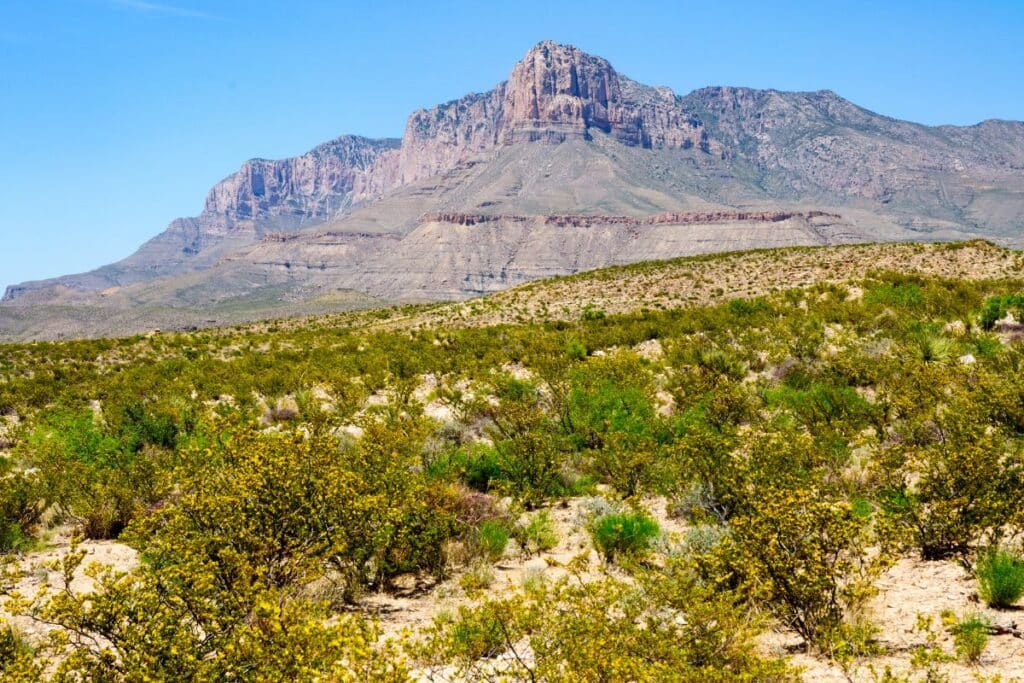
Trails and Exploration: With a sprawling network of over 80 miles of trails, the park allows visitors to traverse its deep canyons, bubbling springs, and towering mountains, all while marveling at the distinctive allure of the Chihuahuan Desert.
Geological Marvels: Among its geological treasures is the world-renowned Permian fossil reef, evidence of the park’s ancient oceanic past.
For those keen on diving deeper into this history, guided tours and informative exhibits are readily available.
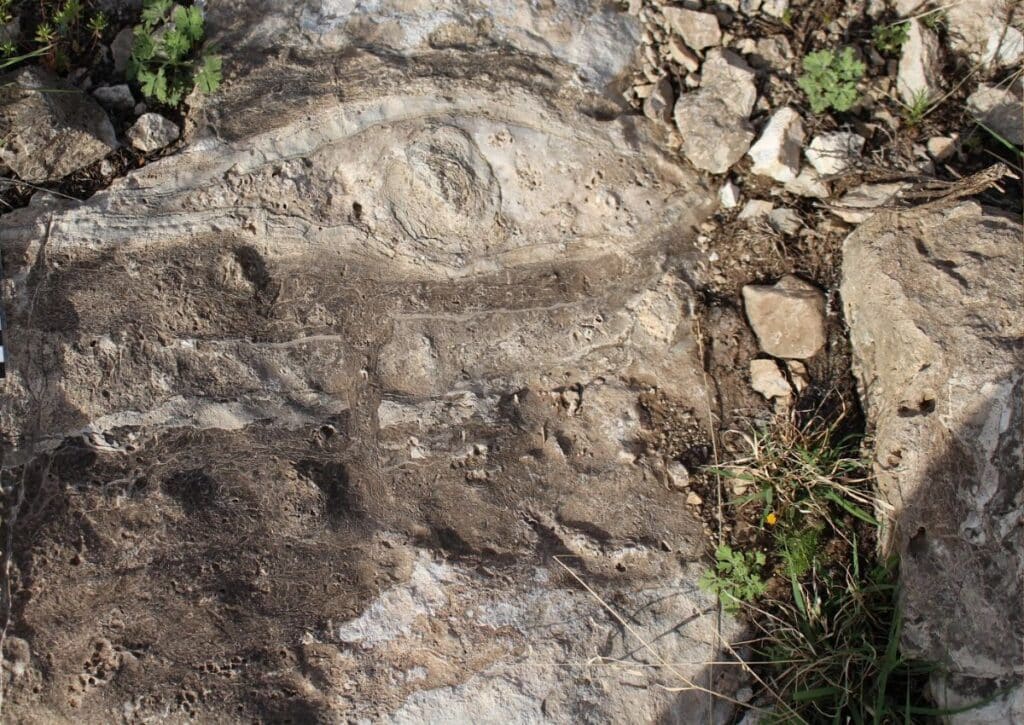
Flora and Fauna: The park is a living spectacle of biodiversity.
From the elusive black bears and mountain lions to a dazzling ensemble of over 300 bird species, nature enthusiasts will find themselves in a paradise of sightings and sounds.

Cultural Legacy: Beyond its natural wonders, the park is a repository of human history spanning over 10,000 years.
From ancient indigenous civilizations to the pioneers of the American West, every corner has a story to tell.
The passage of the Butterfield Overland Mail through this region in the 1800s further underscores its historical significance.
Best Time to Visit Guadalupe Mountains National Park:
Spring: As the cold grip of winter recedes, the park awakens with a vibrant display of wildflowers.
This season not only paints the landscape in a myriad of colors but also ushers in a diverse variety of migratory birds.
Spring is ideal for those eager to capture photographs of nature in full bloom or for enthusiasts looking to tick off rare bird species from their lists.
Summer: While the midday sun can be intense, the extended daylight hours afford visitors more time to uncover the park’s secrets.
Start your adventures early in the morning or as the sun begins its descent to avoid the peak heat.
Summer evenings under the vast Texan sky, studded with stars, is an experience in itself.
Fall: The park undergoes a transformation during fall, with foliage showcasing a spectrum of autumnal hues.
The moderate temperatures and animals gearing up for winter make this season a favorite among hikers and wildlife enthusiasts.
The cooler days mean animals are active for longer periods, increasing your chances of memorable sightings.
Winter: A time of peace and reflection, winter drapes the park in a serene ambiance.
The possibility of witnessing the majestic peaks blanketed in snow is an allure for many.
Though the cold can be biting, the crisp air and quiet trails present a unique perspective of the park’s beauty. Just ensure you’re adequately geared up for the temperatures.
Guadalupe Mountains National Park is more than just a destination; it’s an immersion into the heart of nature, geology, and history.
Whether you’re a first-time visitor or returning for the umpteenth time, the park’s vast wonders promise a memorable experience.
Getting There
Guadalupe Mountains National Park is located in far West Texas, approximately 110 miles east of El Paso and 56 miles southwest of Carlsbad, New Mexico.
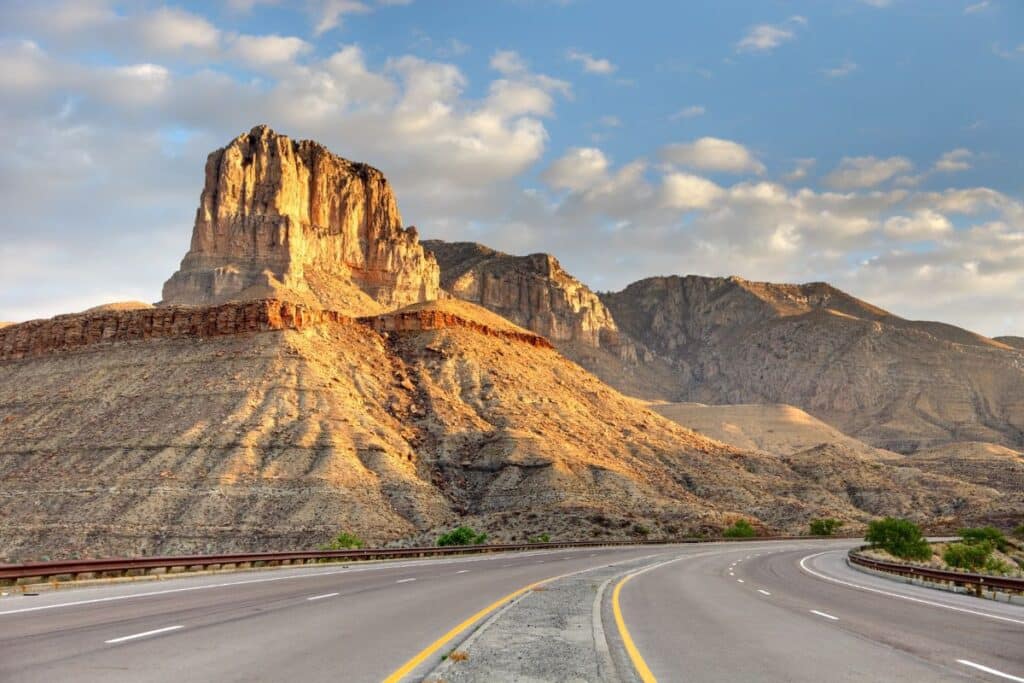
The park’s remote location and striking landscapes make it a must-visit destination for nature lovers and adventure seekers alike.
By road
To reach the park, visitors can travel by car, RV, or motorbike. The primary access route is via US Highway 62/180, which runs along the southern edge of the park.
For those arriving from the east, the park entrance is about 65 miles west of Carlsbad, New Mexico. If you’re coming from the west, the entrance is approximately 110 miles east of El Paso, Texas.
We suggest renting car from El Paso or Carlsbad by using the widget below.
Public Transport
While there is no public transportation directly to the park, visitors can utilize various modes of transportation to reach nearby cities and towns.
Greyhound buses serve both El Paso and Carlsbad, while Amtrak’s Sunset Limited route stops in El Paso, offering train service from cities like Los Angeles, San Antonio, and New Orleans.
From these nearby cities, visitors can rent a car or arrange for a shuttle service to the park.
By Air
For those traveling by air, the nearest airports to Guadalupe Mountains National Park are El Paso International Airport (ELP) in El Paso, Texas, and Cavern City Air Terminal (CNM) in Carlsbad, New Mexico.
El Paso International Airport, located approximately 125 miles from the park, offers a greater variety of flights and airlines, while Cavern City Air Terminal, about 75 miles from the park, is a smaller airport with limited commercial flights.
Upon arrival at either airport, visitors can rent a car or arrange for shuttle service to the park.
Keep in mind that due to its remote location, services and amenities near the park are limited. It is essential to plan ahead and ensure you have adequate supplies, such as food, water, and fuel, before entering the park.
Once you arrive at Guadalupe Mountains National Park, you’ll be rewarded with an unforgettable experience surrounded by natural beauty and a rich history.
Park History and Geology
Formation and Geology
Guadalupe Mountains National Park boasts a fascinating geological history, offering a captivating look into the earth’s past.
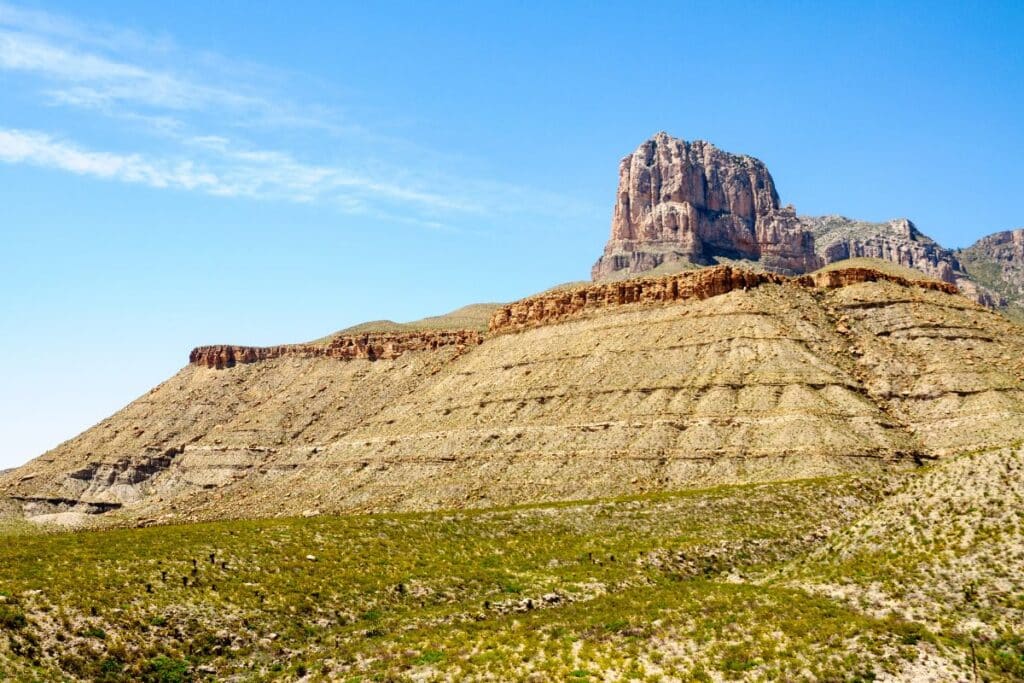
The park’s rugged terrain was formed over millions of years, as ancient seas, tectonic forces, and erosion shaped the landscape.
The dramatic peaks, including Guadalupe Peak and El Capitan, are remnants of the ancient Capitan Reef, which thrived more than 250 million years ago during the Permian Period.
As the seas receded and the continents shifted, the massive limestone reef was exposed, creating the breathtaking formations that visitors enjoy today.
Historical Significance and Past Inhabitants
Beyond its geological wonders, Guadalupe Mountains National Park has a rich cultural history, with evidence of human habitation dating back over 10,000 years.
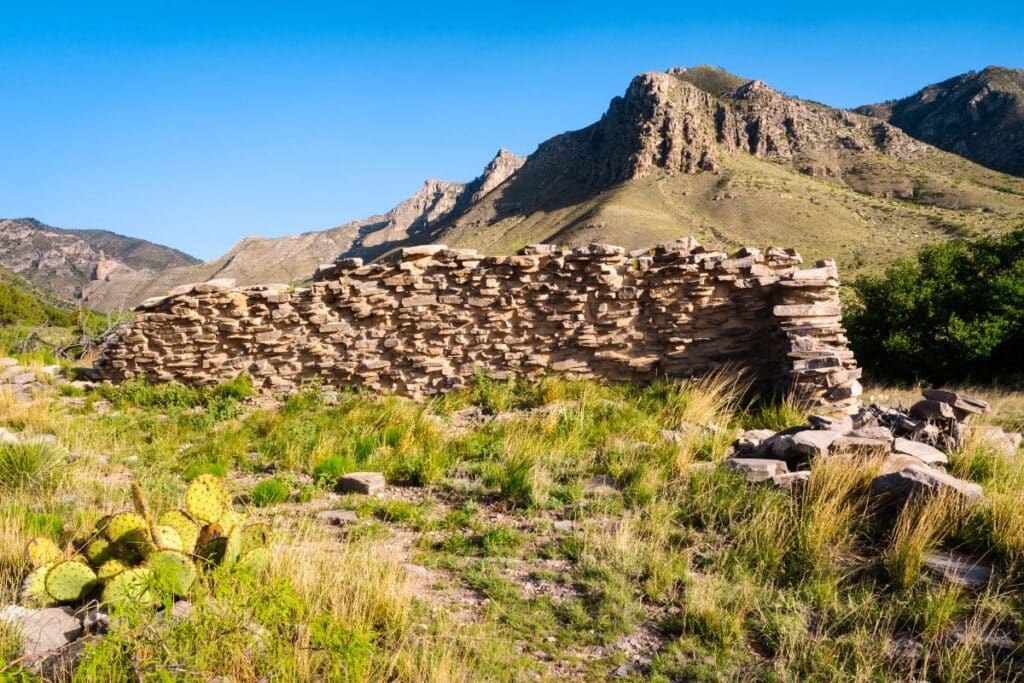
Native American groups, such as the Mescalero Apaches, called this region home, leaving behind pictographs and other artifacts as testament to their presence.
In the 19th and early 20th centuries, settlers, ranchers, and miners were drawn to the area, leaving their mark on the landscape through structures like the Frijole Ranch and the Williams Ranch House.
Fossils and Ancient Marine Life
The park’s unique geology also reveals a treasure trove of fossils, offering glimpses into the vibrant marine life that once inhabited the ancient seas.
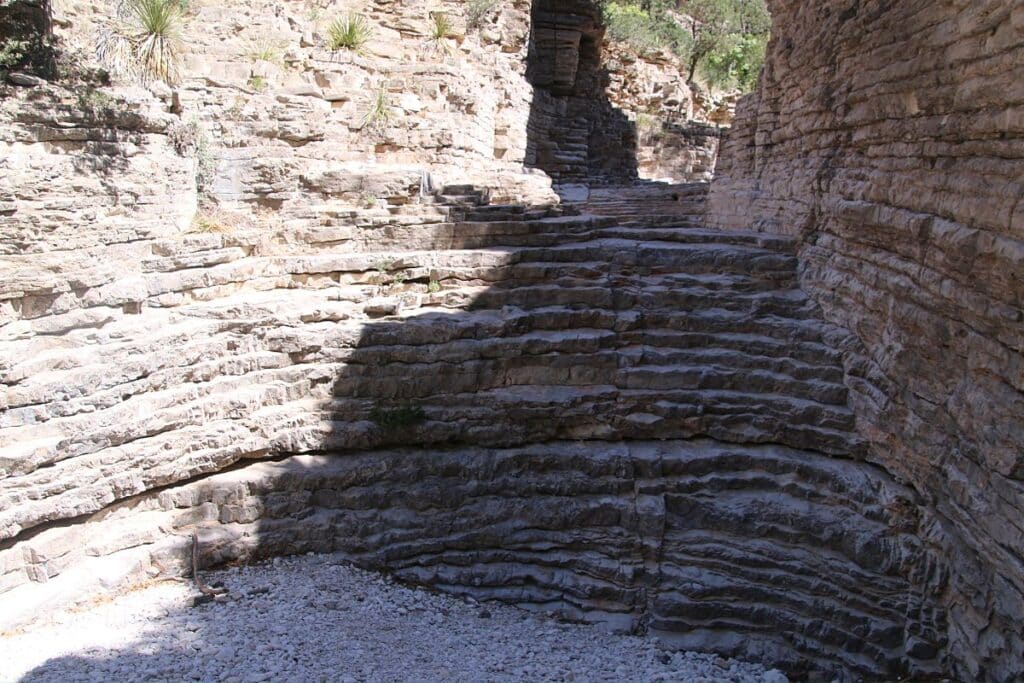
Fossilized remains of sponges, algae, brachiopods, and other marine creatures can be found throughout the park, providing a fascinating window into the region’s prehistoric past.
The Permian Reef Geology Trail, in particular, allows visitors to explore the park’s geological history up close, with interpretive displays and fossil specimens that bring the ancient reef to life.
With its awe-inspiring geological formations, rich cultural history, and abundant fossil record, Guadalupe Mountains National Park offers an exciting and educational experience for visitors of all ages.
Whether you’re an avid hiker, a history buff, or a budding paleontologist, this park is a must-see destination that will leave you with unforgettable memories and a deeper appreciation for the wonders of our natural world.
Wildlife and Flora
Guadalupe Mountains National Park is a thriving haven for a diverse range of flora and fauna, thanks to its unique topography and ecosystems.
The park’s varied landscapes, including the Chihuahuan Desert, lush riparian areas, rocky mountain slopes, and high-elevation coniferous forests, support an array of plant and animal species.
As you explore the park, you’ll encounter a rich tapestry of life, from vibrant wildflowers and ancient trees to elusive mammals, birds, and reptiles.
Animals Commonly Seen on the Trails in Guadalupe Mountains National Park
As you journey through Guadalupe Mountains National Park, keep an eye out for some of the incredible wildlife that calls this area home.
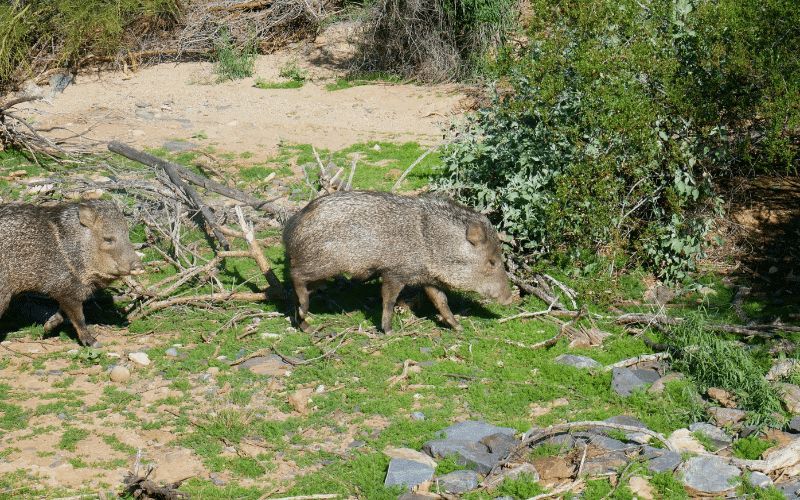
Our guide to the wildlife in the Guadalupe Mountains National Park, is a must-read to prepare for your trip!
Here are a few animals you might spot during your visit:
Mule Deer: These large, majestic deer can often be seen grazing in the park’s meadows and forests, easily recognizable by their large, mule-like ears.
Javelina: Also known as collared peccaries, these pig-like mammals can be found roaming in small groups or foraging for food in the desert scrubland.
Black Bear: Although sightings are relatively rare, black bears do inhabit the park’s higher elevations. Remember to practice proper food storage and be cautious if you come across one.
Gray Fox: These small, agile canines are known for their ability to climb trees and are most active during the early morning and evening hours.
Elk: Majestic and graceful, elk can be spotted in the park’s higher elevations, especially around The Bowl area.
Mountain Lion: Though elusive and seldom seen, these apex predators do roam the park. Be sure to follow safety guidelines if you encounter one.
Golden Eagle: Keep your eyes on the sky for a chance to spot these impressive raptors soaring above the park’s peaks and canyons.
Roadrunner: A symbol of the Southwest, the roadrunner is a speedy, ground-dwelling bird that can often be seen darting through the desert shrubland.
Western Diamondback Rattlesnake: While not a creature you’d want to get too close to, these venomous snakes are an important part of the park’s ecosystem. Be cautious and give them plenty of space.
Merriam’s Kangaroo Rat: These tiny, nocturnal rodents can be seen hopping about in the park’s desert areas, using their powerful hind legs to escape predators.
For more detailed information and photos of these amazing creatures, be sure to visit this guide!
Unique Plants and Ecosystems
In addition to its diverse wildlife, Guadalupe Mountains National Park is home to a wide variety of plant species, some of which are found nowhere else in the world.
From delicate wildflowers to towering trees, the park’s flora is as captivating as its fauna.
One of the most iconic plant species in the park is the Ponderosa Pine, which thrives in the higher elevations, creating a lush, green oasis amid the rugged terrain.
In McKittrick Canyon, you’ll find an enchanting mix of deciduous trees such as Bigtooth Maples and Velvet Ash, whose leaves turn brilliant shades of red, orange, and yellow in the fall, creating a breathtaking display.
In the Chihuahuan Desert ecosystem, you’ll come across hardy plants such as agaves, yuccas, ocotillos, and a variety of cacti.
These plants have adapted to the harsh desert conditions and play a crucial role in supporting the region’s wildlife.
As you explore the park, be sure to take the time to appreciate the small wonders of the plant world, such as the delicate blooms of the Claret Cup Cactus or the whimsical forms of the Cholla cactus.
The park’s riparian areas, found in places like McKittrick Canyon and near Smith Spring, support a different set of flora.
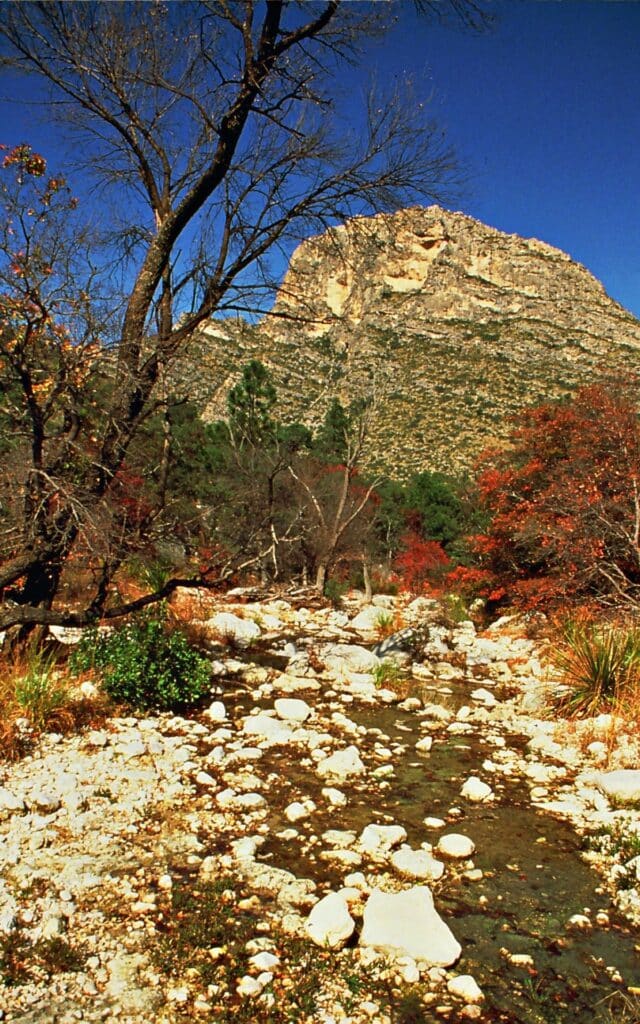
These lush, green oases are home to cottonwood and willow trees, providing crucial habitat for a variety of bird species and other wildlife.
The unique combination of desert, riparian, and forest ecosystems within the park allows for an incredible range of plant life to flourish.
When visiting Guadalupe Mountains National Park, be sure to take the time to immerse yourself in the diverse ecosystems and admire the remarkable plant life that calls this area home.
As you hike the park’s trails and explore its varied landscapes, you’ll gain a deeper appreciation for the intricate web of life that thrives in this extraordinary corner of West Texas.
Top Hiking Trails in Guadalupe Mountains National Park
Guadalupe Mountains National Park offers a diverse range of trails that cater to hikers of all skill levels.
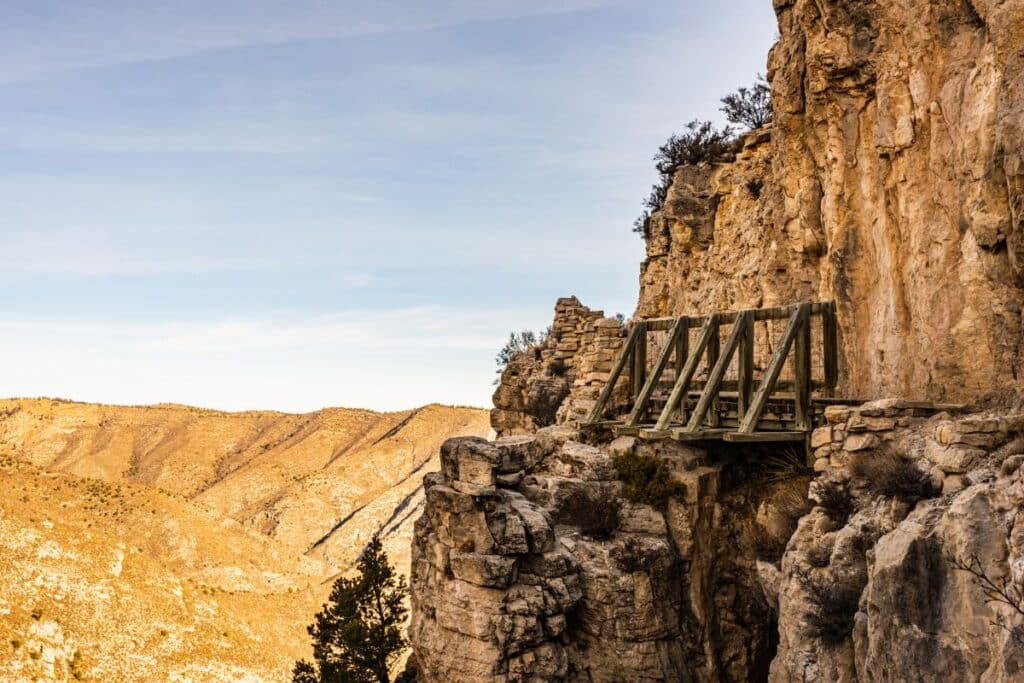
Whether you’re seeking a leisurely stroll through a riparian oasis, a challenging ascent to the highest peak in Texas, or an immersive journey through the park’s fascinating geological history, use our article on hiking trails to choose!
Guadalupe Peak Trail
The crown jewel of the park, the Guadalupe Peak Trail, takes you to the highest point in Texas, standing at 8,749 feet.
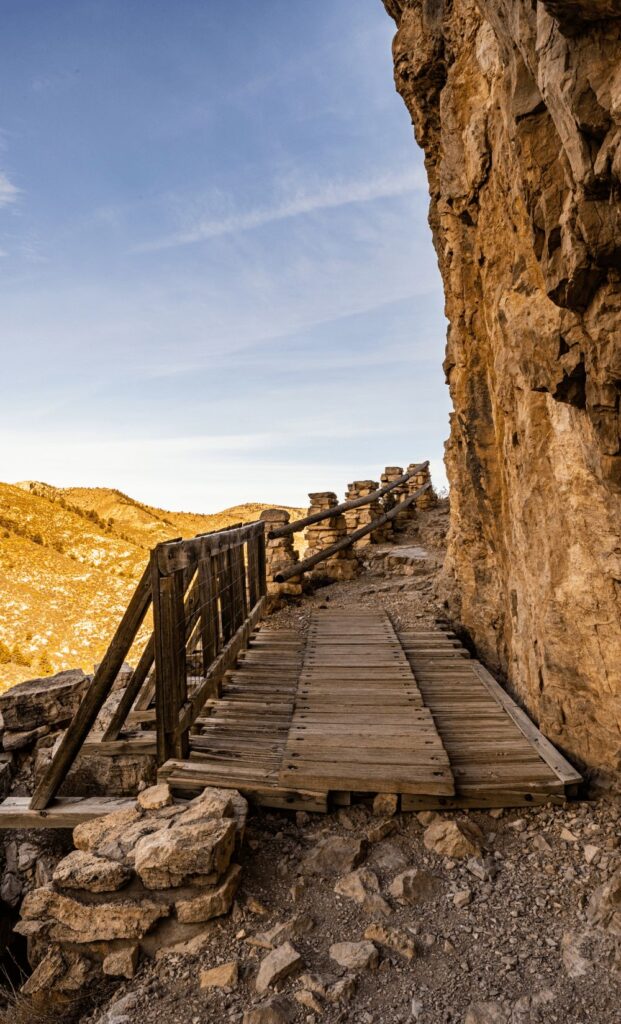
This challenging 8.4-mile round-trip hike gains over 3,000 feet in elevation and rewards hikers with unparalleled panoramic views of the surrounding landscape.
McKittrick Canyon Trail
McKittrick Canyon Trail is known for its incredible fall foliage display, as the Bigtooth Maples and other deciduous trees in the canyon turn vibrant shades of red, orange, and yellow.
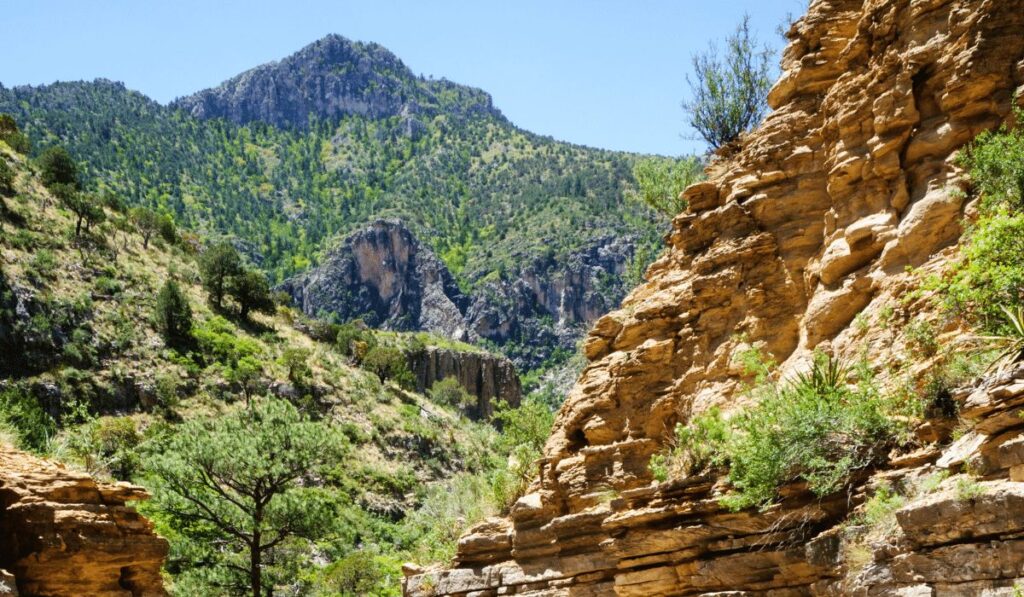
This 4.8-mile round-trip trail leads to the stunning Grotto, a unique limestone alcove adorned with delicate ferns.
Devil’s Hall Trail
This moderate 4.2-mile round-trip hike takes you through a rocky wash, culminating in the impressive natural staircase of the Hiker’s Staircase and the narrow, towering walls of Devil’s Hall.
The trail showcases the park’s geological wonders, including the signature limestone layers.
Smith Spring Trail
A 2.3-mile loop trail, Smith Spring Trail, takes you through a mix of desert and riparian habitats.
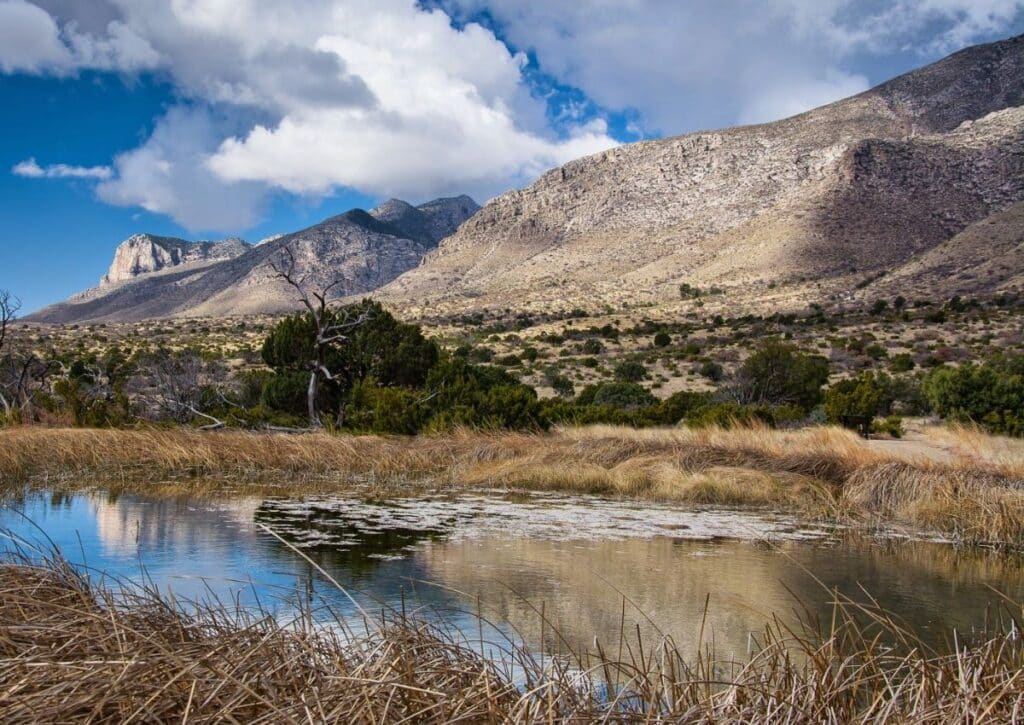
The trail leads to Manzanita Spring and Smith Spring, providing a lush, green oasis that supports a variety of plant and animal species.
It’s an excellent choice for birdwatching and wildlife spotting.
El Capitan Trail
This strenuous, 11.3-mile round-trip hike takes you along the base of the iconic El Capitan formation and offers incredible views of the surrounding desert landscape.
The trail can be combined with the Guadalupe Peak Trail for a challenging, full-day adventure.
The Bowl Trail
The Bowl Trail is a 9.1-mile round-trip hike that takes you through diverse ecosystems, from desert scrub to lush coniferous forests.
The trail leads to The Bowl, a high-elevation, forested area that provides a cool respite from the desert heat and is home to an array of wildlife, including elk.
Salt Basin Dunes Trail
This relatively flat, 2-mile round-trip trail takes you to the otherworldly Salt Basin Dunes, a unique gypsum sand dune field on the western edge of the park.
The trail offers fantastic opportunities for photography and is best visited in the early morning or late afternoon to catch the stunning play of light and shadow on the dunes.
Frijole Ranch Trail
This 2.3-mile round-trip trail starts at the historic Frijole Ranch and takes you past Manzanita Spring before looping back through a mix of desert and riparian habitats.
The trail provides an excellent opportunity to learn about the park’s ranching history while enjoying its natural beauty.
Williams Ranch Road
This 7.4-mile one-way trail (14.8 miles round-trip) takes you to the remote and historic Williams Ranch House, nestled in the heart of the park.
The trail offers a unique off-the-beaten-path experience and requires a high-clearance vehicle or a lengthy hike to reach the ranch.
Be prepared for an adventure and keep an eye out for wildlife along the way.
Permian Reef Geology Trail
For those interested in the park’s fascinating geological history, the 8.4-mile round-trip Permian Reef Geology Trail is a must-do.
This trail takes you through an ancient fossil reef, with interpretive displays and fossil specimens that bring the region’s prehistoric past to life.
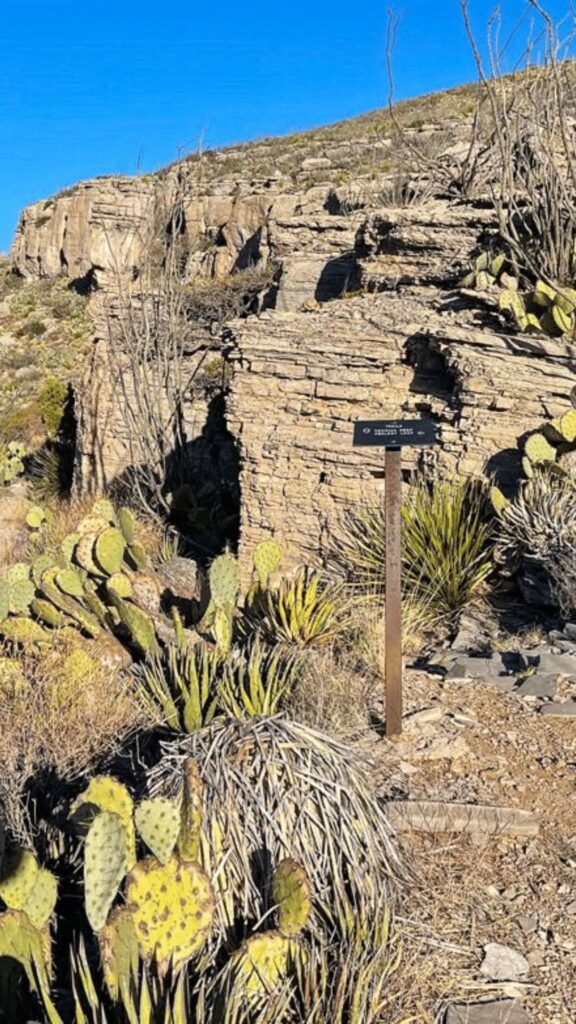
Be prepared for a challenging hike with steep sections and rewarding views.
Guadalupe Mountains National Park offers a diverse range of trails that cater to all interests and skill levels.
Make sure to read our article on trails in Guadalupe Mountain National Park to choose from many exciting trails.
Campgrounds in Guadalupe Mountains National Park
Guadalupe Mountains National Park offers visitors a variety of camping options to suit their needs and preferences.
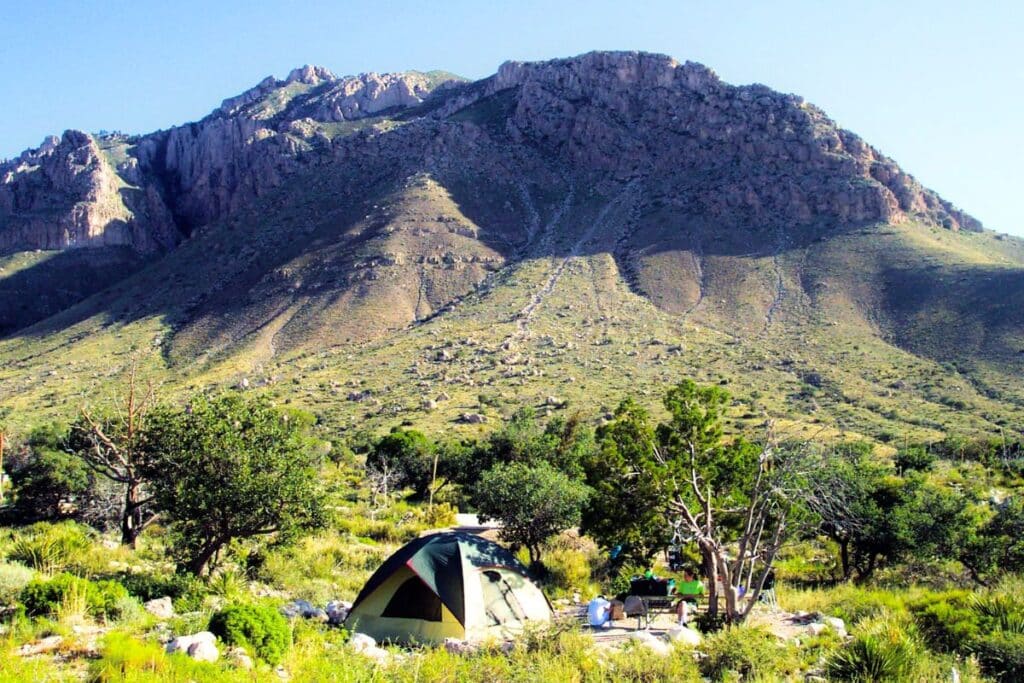
From developed campgrounds with facilities to primitive backcountry camping, there is something for everyone. In this section, we will explore the different camping options available in the park.
Pine Springs Campground
Pine Springs Campground is the park’s primary developed campground, conveniently located near the Pine Springs Visitor Center and providing easy access to popular trails like the Guadalupe Peak Trail and Devil’s Hall Trail.
The campground features 20 tent sites and 19 RV sites (no hookups) on a first-come, first-served basis.
Amenities include restrooms, drinking water, picnic tables, and grills. The campground is open year-round and offers stunning views of the surrounding mountains.
Dog Canyon Campground
Located on the park’s northern side, Dog Canyon Campground offers a more secluded and peaceful camping experience.
The campground has nine tent sites and four RV sites (no hookups) available on a first-come, first-served basis.
Amenities include restrooms, drinking water, picnic tables, and grills. Dog Canyon is also a great base for exploring the park’s backcountry trails, such as the Bowl Trail and the Bush Mountain Trail.
Primitive Camping
For those seeking a more remote and immersive experience, the park offers backcountry camping in designated sites throughout its wilderness areas.
A free backcountry use permit is required and can be obtained at the Pine Springs or Dog Canyon Visitor Centers.
Be prepared to pack in all your gear, including water, and practice Leave No Trace principles to preserve the park’s pristine wilderness.
Group Camping and Equestrian Campsites
Guadalupe Mountains National Park offers group camping options at both Pine Springs and Dog Canyon Campgrounds.
These group sites can accommodate larger parties and must be reserved in advance through the park’s website or by calling the visitor center.
In addition, equestrian campsites are available at the Frijole Ranch and Dog Canyon areas for visitors exploring the park on horseback.
These sites require a free equestrian use permit, which can be obtained at the Pine Springs or Dog Canyon Visitor Centers.
RV Camping and Accessibility
While the park does not provide RV hookups, both Pine Springs and Dog Canyon Campgrounds offer sites suitable for RVs.
However, note that these campgrounds have size restrictions, and larger RVs may not be accommodated.
It’s essential to check the park’s website or call the visitor center for specific information on RV site sizes and availability.
Camping Rules and Regulations
To ensure a safe and enjoyable experience for all visitors, Guadalupe Mountains National Park has established several camping rules and regulations.
Some key rules to keep in mind include:
- Campsites are available on a first-come, first-served basis, with no reservations for individual sites.
- The maximum stay is 14 days within a 30-day period.
- Quiet hours are from 8 p.m. to 8 a.m.
- Pets must be on a leash no longer than six feet and are not allowed on trails, in the backcountry, or in buildings.
- Campfires are prohibited, but camp stoves and charcoal grills are allowed.
- Do not feed wildlife and practice proper food storage to avoid attracting wildlife to your campsite.
- Follow Leave No Trace principles to minimize your impact on the park’s environment.
For a complete list of camping rules and regulations, be sure to consult the park’s website or inquire at the visitor center.
We have been camping here for 3 decades and have a few favorites, found here!
10 Things to do in GUadalupe mountains national park
Guadalupe Mountains National Park, with its unique blend of history, geology, and natural beauty, offers some unparalleled experiences. Here are ten unique things to do in the park:
- Permian Fossil Exploration: Dive deep into history by visiting the world’s most extensive Permian fossil reef.
The park offers interpretive panels and ranger-led programs that detail the significance of these ancient ocean remnants, helping visitors envision a time when West Texas lay beneath a vast sea.
- Summit the Guadalupe Peak: As Texas’s highest point, this challenging hike rewards with breathtaking panoramic views.
The trail extends approximately 8.4 miles round-trip with an elevation gain of 2,930 feet.
Along the way, you’ll traverse various ecosystems and, once at the peak, stand atop a unique stainless steel pyramid marking the summit.
- McKittrick Canyon Fall Colors: A not-to-miss autumnal spectacle, McKittrick Canyon comes alive with colors from late October to early November.
Guided tours during this season help visitors understand the unique flora responsible for this desert oasis’s vivid transformation.
- Explore the Salt Basin Dunes: These glistening white gypsum dunes span 2,000 acres.
To get there, you’ll need to drive outside the park’s main area, but the surreal, shifting landscape, particularly during the golden hours of sunrise and sunset, is well worth the trip.
- Stargazing Sessions: The park’s remote location offers minimal light pollution, making it an astronomer’s dream.
Regular ranger-led night programs delve into cosmic wonders, from meteor showers to the tales behind constellations.
Ensure you bring a blanket or reclining chair for comfortable viewing.
- Discover the Butterfield Overland Mail Route: Historians and hiking enthusiasts can follow parts of the trail that once served as a crucial mail and passenger route.
Interpretative signs along the way offer snippets of stories, detailing the challenges and triumphs of early mail carriers.
- Devil’s Hall Hike: A 4.2-mile round-trip trail, this hike is renowned for its staircase-like natural rock formation and the narrow, picturesque hallway of eroded boulders.
Suitable for most fitness levels, this trail offers a unique blend of hiking challenges and geological wonder.
- Birdwatching Extravaganza: The park’s diverse habitats support over 300 bird species. Key areas include the Dog Canyon, Frijole Ranch, and McKittrick Canyon.
Spring and fall migrations are particularly rewarding, and dedicated birdwatchers should consider bringing binoculars and a field guide to spot and identify species.
- Williams Ranch Tour: A step back in time, this historic ranch stands as a testament to the rugged life of early settlers.
Accessing the ranch requires a high-clearance vehicle, and visitors should plan to spend time exploring the ranch house, outbuildings, and absorbing the solitude of this remote location.
- Cave Exploration at Slaughter Canyon: Dive beneath the surface with a ranger-led tour of Slaughter Canyon Cave.
Though less frequented than nearby Carlsbad Caverns, the cave boasts its wonders, such as the Monarch—a massive column stretching from floor to ceiling—and the Christmas Tree, a sparkling, decorated stalagmite.
Visitor Information and Park Accessibility
Park Fees and Passes
Guadalupe Mountains National Park has a nominal entrance fee for visitors, which helps support the park’s maintenance and operations. The fees are as follows:
Individual (on foot, bicycle, or horse): $10 per person, valid for 7 days
Vehicle: $20 per vehicle, valid for 7 days
Motorcycle: $15 per motorcycle, valid for 7 days
Additionally, the park offers annual passes for frequent visitors, available for $35 and valid for one year from the purchase date.
If you plan on visiting other national parks, consider purchasing an America the Beautiful National Parks and Federal Recreational Lands Pass, which grants access to over 2,000 federal recreation sites for an annual fee of $80.
Visitor Centers
Guadalupe Mountains National Park has two visitor centers, Pine Springs Visitor Center and Dog Canyon Ranger Station, which serve as essential resources for visitors.
The visitor centers offer park information, maps, backcountry permits, exhibits, restrooms, and picnic areas.
The Pine Springs Visitor Center also has a small bookstore operated by the Western National Parks Association.
Park Safety and Rules
To ensure a safe and enjoyable visit, it’s crucial to follow the park’s safety guidelines and rules. Some essential safety tips include:
- Stay on designated trails to minimize your impact on the environment and avoid getting lost.
- Carry plenty of water, especially during the hot summer months, and stay hydrated.
- Be prepared for changing weather conditions, as temperatures can vary significantly between day and night and at different elevations.
- Keep a safe distance from wildlife and never feed them.
- Follow Leave No Trace principles to minimize your impact on the park’s environment.
For a complete list of park rules and safety guidelines, consult the park’s website or inquire at the visitor center.
Seasonal Events and Activities
Guadalupe Mountains National Park offers various seasonal events and activities, allowing visitors to enjoy the park’s unique features throughout the year. Some popular seasonal highlights include:
- Spring: Wildflower blooms, mild temperatures, and bird migrations make spring an ideal time for hiking and exploring the park’s diverse ecosystems.
- Summer: With hotter temperatures, visitors can seek refuge in the park’s higher elevations, where cooler temperatures prevail. Early morning and late afternoon hikes are recommended to avoid the midday heat.
- Fall: The spectacular fall foliage display in McKittrick Canyon attracts visitors from all over the country. This is also a popular time for birdwatching, as many migratory species pass through the park.
- Winter: With cooler temperatures and fewer visitors, winter offers a serene and peaceful experience. Many trails remain accessible, but visitors should be prepared for possible snow and icy conditions at higher elevations.
Accessibility and Accommodations for Visitors with Disabilities
Guadalupe Mountains National Park strives to provide an enjoyable and accessible experience for all visitors. Some accessible facilities and accommodations include:
- Accessible parking spaces and restrooms are available at the Pine Springs Visitor Center, Frijole Ranch, and Dog Canyon Ranger Station.
- The Pinery Trail, a short, paved nature trail near the Pine Springs Visitor Center, is wheelchair-accessible and offers interpretive exhibits about the park’s flora and fauna.
- The park’s campgrounds, Pine Springs and Dog Canyon, have designated accessible campsites with nearby accessible restrooms.
- The park’s visitor centers, picnic areas, and some overlooks offer accessible facilities and paths.
For more detailed information on accessibility in the park, consult the park’s website or contact the visitor center.
Final Thoughts
Guadalupe Mountains National Park stands as a testament to nature’s grandeur and historical depth. Beyond its soaring peaks and the intricate tapestry of ecosystems, it offers a diverse playground for explorers.
Whether you’re tracing the contours of the world’s most extensive Permian fossil reef, gazing at the unparalleled vistas from Texas’ highest peak, or finding solace under a canopy of stars, the park beckons with promise.
Every season unveils a different facet: the captivating spring blooms, the golden hues of autumn foliage, or the winter’s serene embrace. Each trail, whether trekked solo or with loved ones, reveals stories — both of the land and of oneself.
Having dived into the essence of Guadalupe Mountains National Park through this overview, the next step is yours. As you plan your visit, delve deeper into available resources, including the park’s official website, to tailor your journey.
So, as you set forth on this adventure, remember: Guadalupe isn’t just a destination; it’s an experience. Gather your essentials, rally your companions, and let the magic of this magnificent terrain wash over you.
What is the history of Guadalupe Mountains National Park?
Guadalupe Mountains National Park has a rich history dating back to the prehistoric period. The park has been home to various Native American tribes, including the Mescalero Apache and the Jumano. In the early 1900s, the area was used for ranching and mining. In 1966, the park was established to preserve the unique landscape and wildlife of the region.
How big is Guadalupe Mountains National Park?
Guadalupe Mountains National Park covers over 86,000 acres of land, making it one of the largest wilderness areas in Texas. The park features several mountain peaks, including Guadalupe Peak, the highest point in Texas.
When was Guadalupe Mountains National Park established?
Guadalupe Mountains National Park was established on September 30, 1972, by President Richard Nixon. The park was created to protect the unique geological formations and diverse wildlife of the region.
What is the entrance fee for Guadalupe Mountains National Park?
The entrance fee for Guadalupe Mountains National Park is $10 per person for visitors 16 years and older. The fee is valid for seven days and includes access to all areas of the park.
How do I get to Guadalupe Mountains National Park?
Guadalupe Mountains National Park is located in western Texas on the border of New Mexico and Texas. The closest major city is El Paso, which is about 110 miles away. Visitors can access the park by car via US Highway 62/180 or by air through El Paso International Airport.
Is Guadalupe Mountains National Park worth visiting?
Absolutely! Guadalupe Mountains National Park offers a unique and breathtaking landscape, with towering mountain peaks, vast wilderness, and diverse wildlife. Visitors can enjoy a variety of outdoor activities, including hiking, camping, and wildlife watching. Whether you’re a seasoned outdoor enthusiast or a first-time visitor, Guadalupe Mountains National Park is definitely worth a visit.

